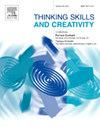阿根廷的创造力和教师教育课程
IF 3.7
2区 教育学
Q1 Social Sciences
引用次数: 0
摘要
创造力是教育机构和教师教育的一种重要能力。然而,先前的研究表明,在课程文件中,关于如何在教育环境中促进创造性过程的一般定义和很少的方法指导方针占主导地位。本研究的目的是分析阿根廷教师教育计划的课程文件,考虑到在目标、内容和教学指导方针中给予创造力的地位。该研究整合了二手信息来源的定量(JAMOVI2.5.6)和定性(MAXQDA24)分析。具体而言,该语料库包括阿根廷国家教师培训学院官方网站上的11个课程文件和阿根廷Córdoba(阿根廷)高等教育部发布的23个教师培训项目。结果表明,创造力主要与艺术学科有关。与创造力相关的术语最常出现在视觉艺术、音乐、舞蹈和戏剧课程中。分析揭示了与创造力相关的四个一般目的:主观表达、跨学科整合、解决问题和知识生产。一般来说,课程文件没有对创造力给出明确的、理论上有根据的定义;这种构念作为横向能力的潜力尚不清楚。至关重要的是,课程政策应恢复创造力研究领域的当前发展,认识到不同知识领域中创造性过程的重要性。在高等教育和其他层次的教育中,也有必要将创造性作为思考新的教学实践的空间。本文章由计算机程序翻译,如有差异,请以英文原文为准。
Creativity and teacher education curricula in Argentina
Creativity is a valued competence in educational institutions and teacher education. However, previous research indicates that general definitions and few methodological guidelines on how to promote creative processes in educational contexts predominate in curricular documents. The objective of this study is to analyse the curricular documents of teacher education programs in Argentina, considering the place given to creativity in the objectives, content and pedagogical guidelines. The study integrates quantitative (JAMOVI2.5.6) and qualitative (MAXQDA24) analyses of secondary sources of information. Specifically, the corpus consists of eleven curricular documents available on the official website of the National Institute of Teacher Training of Argentina and twenty-three teacher training programs published by the Department of Higher Education of Córdoba (Argentina). The results show that creativity is mainly associated with artistic disciplines. Terms related to creativity appear most frequently in the curricula of visual arts, music, dance and theatre. The analysis reveals four general purposes related to creativity: subjective expression, interdisciplinary integration, problem solving and knowledge production. In general, curricular documents do not present clear and theoretically grounded definitions of creativity; the potential of this construct as a transversal competence is unknown. It is essential that curricular policies recover current developments in the field of creativity research, recognizing the importance of creative processes in the different fields of knowledge. It is also necessary to establish creativity as a space for thinking about new teaching practices in higher education and other levels of education.
求助全文
通过发布文献求助,成功后即可免费获取论文全文。
去求助
来源期刊

Thinking Skills and Creativity
EDUCATION & EDUCATIONAL RESEARCH-
CiteScore
6.40
自引率
16.20%
发文量
172
审稿时长
76 days
期刊介绍:
Thinking Skills and Creativity is a new journal providing a peer-reviewed forum for communication and debate for the community of researchers interested in teaching for thinking and creativity. Papers may represent a variety of theoretical perspectives and methodological approaches and may relate to any age level in a diversity of settings: formal and informal, education and work-based.
 求助内容:
求助内容: 应助结果提醒方式:
应助结果提醒方式:


